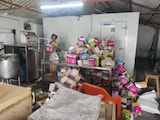DoorDash Inc. is partnering with sidewalk-robot developer Serve Robotics Inc. for autonomous deliveries across the US, adding to an array of methods the company is exploring to complement human couriers.
Serve's robots will fulfill some DoorDash orders through a multiyear partnership, starting in Los Angeles, the companies said Thursday in a statement shared with Bloomberg News. Serve, which also counts DoorDash rival Uber Technologies Inc. as a partner, has completed tens of thousands of deliveries in five US cities: LA, Miami, Dallas, Chicago and Atlanta.
Neither partnerships is exclusive, meaning Serve can optimize its robots' time by taking orders from both DoorDash and Uber, similar to how delivery workers toggle between multiple apps to find better-paying or nearby gigs. Serve shares jumped 29% to $17.68 at the close in New York, the biggest single-day increase in nine months.
DoorDash, the leading US app for food deliveries, has articulated a vision of using both human couriers and autonomous transportation. In April, it expanded its partnership with another sidewalk robot company, Coco Robotics, for orders in LA and Chicago. And last week it unveiled its own delivery robot developed in-house, which it said is built for suburban markets where it can deliver bigger orders, at faster speeds and across longer distances on both sidewalks and roads.
"It's a good validation because now we are seeing both of the major platforms in the country investing quite a bit in autonomy," Serve Chief Executive Officer Ali Kashani said of DoorDash's in-house robot in an interview. "For the longest time, for eight years, we've been kind of screaming this off the rooftops, and now we have more support for that."
DoorDash has said humans can best handle complex, multi-stop orders that are higher-paying, while sidewalk robots, which have limited speed, are better suited for smaller, short-distance dispatches in urban markets. (Serve's average delivery is under a mile and takes around 18 minutes from pickup to drop-off.) DoorDash is also testing drone deliveries with Flytrex Inc. and Alphabet Inc.'s Wing in the US and Australia; that method is best for small and fast orders.
Serve is looking to double its fleet to 2,000 robots on the road by the end of this year - and the strategy to partner with multiple delivery apps could help make that investment more fruitful.
The company, which counts Uber as an investor after it spun off from the Uber-acquired delivery service Postmates, is not yet profitable, but Chief Financial Officer Brian Read has said that a larger fleet can boost revenue and operating leverage. Keeping the robots busy with both DoorDash and Uber deliveries could help reduce so-called deadhead miles - empty trips where the bot isn't fulfilling orders - allowing Serve to increase its returns without additional capital.
Serve currently focuses on food delivery on sidewalks, but Kashani expects to eventually expand the uses for its robots, including transport for items like groceries or medication, and in settings like shopping malls, factory floors or hospitals.
"To me, food delivery is the book to our Amazon," he said. "We're just starting with that as a first market, but there is almost infinite demand for where we can go."
(Except for the headline, this story has not been edited by NDTV staff and is published from a syndicated feed.)















